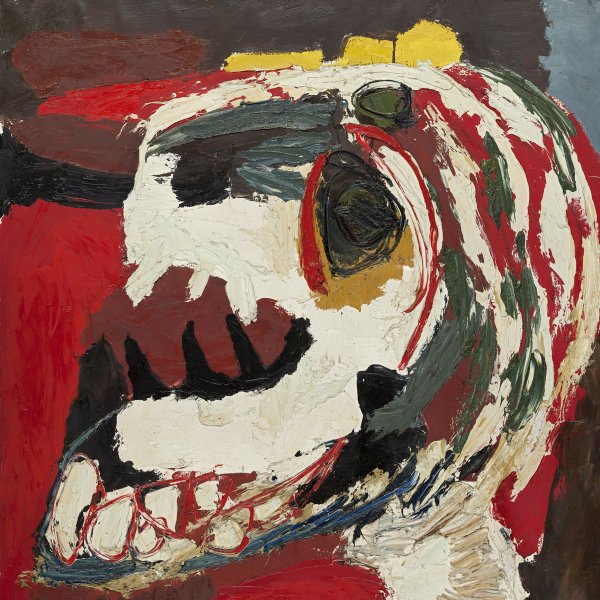Karel Appel
Amsterdam, 1921-Zurich, 2006
“I paint like a barbarian in these barbarian times, ” stated the Dutch artist Karel Appel of his own work, which embraced the trends in Art Informel that proliferated after the end of the Second World War.
While a student at the Rijksakademie between 1940 and 1943, Appel was attracted by the force of the textured paintings of the German Expressionists and Van Gogh. His works were aggressive and provocative, yet had a childlike simplicity, and appeared to be connected with the transgressive spirit of the Surrealists. He met Constant and Corneille, with whom he established the Experimentele Groep in July 1948. The same year, together with Asger Jorn, Joseph Noiret and Christian Dotremont, they signed the manifesto La Cause est entendue, which advocated a spontaneous art without rules, similar to the creations of children and the insane, and gave rise to the CoBrA movement. A few months later, to mark the group’s first exhibition in Amsterdam, Appel executed a mural entitled Questioning Children for the cantine of the Town Hall building, which triggered such a scandal in the city that it was covered over for the next ten years.
In 1950 Appel moved to Paris, where, thanks to Michel Tapié’s support, he was able to work with better quality materials. Turbulent areas heavily caked with paint gradually took over from the figurative motifs, animals and people that had previously dominated his painting. He first travelled to New York in 1957 and thereafter divided his time between France, where he resided in a castle he bought at Molesmes in 1964, and long stays in the United States. Around this time his work began to be widely acclaimed internationally and shown periodically at the Martha Jackson Gallery in New York and at the Studio Facchetti in Paris.
Appel was a tireless artist who explored a whole host of languages from sculpture, ceramics and mural painting to stained glass and engraving. Throughout his lengthy artistic career he received numerous awards and collaborated with creators from other disciplines such as the poet Allen Ginsberg and the choreographer Min Tanaka.
While a student at the Rijksakademie between 1940 and 1943, Appel was attracted by the force of the textured paintings of the German Expressionists and Van Gogh. His works were aggressive and provocative, yet had a childlike simplicity, and appeared to be connected with the transgressive spirit of the Surrealists. He met Constant and Corneille, with whom he established the Experimentele Groep in July 1948. The same year, together with Asger Jorn, Joseph Noiret and Christian Dotremont, they signed the manifesto La Cause est entendue, which advocated a spontaneous art without rules, similar to the creations of children and the insane, and gave rise to the CoBrA movement. A few months later, to mark the group’s first exhibition in Amsterdam, Appel executed a mural entitled Questioning Children for the cantine of the Town Hall building, which triggered such a scandal in the city that it was covered over for the next ten years.
In 1950 Appel moved to Paris, where, thanks to Michel Tapié’s support, he was able to work with better quality materials. Turbulent areas heavily caked with paint gradually took over from the figurative motifs, animals and people that had previously dominated his painting. He first travelled to New York in 1957 and thereafter divided his time between France, where he resided in a castle he bought at Molesmes in 1964, and long stays in the United States. Around this time his work began to be widely acclaimed internationally and shown periodically at the Martha Jackson Gallery in New York and at the Studio Facchetti in Paris.
Appel was a tireless artist who explored a whole host of languages from sculpture, ceramics and mural painting to stained glass and engraving. Throughout his lengthy artistic career he received numerous awards and collaborated with creators from other disciplines such as the poet Allen Ginsberg and the choreographer Min Tanaka.




